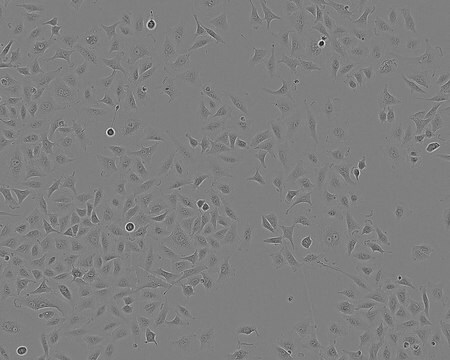DMS 79
95062824, human lung, Irregular
Iniciar sesiónpara Ver la Fijación de precios por contrato y de la organización
About This Item
UNSPSC Code:
41106514
Productos recomendados
product name
DMS 79, 95062824
biological source
human lung
growth mode
Aggregates in suspension
karyotype
Aneuploid
morphology
Irregular
products
Not specified
receptors
Not specified
technique(s)
cell culture | mammalian: suitable
relevant disease(s)
cancer
shipped in
dry ice
storage temp.
−196°C
Cell Line Origin
Human lung small cell carcinoma
Cell Line Description
DMS79 has been established from pleural fluid of a patient with small cell carcinoma of the lung. The patient was treated with cytoxan, vincristine, methotrexate and radiation therapy. The cultures show a tendency for the modal chromosome number to decline. The production of adrenocorticotropin (ACTH), bombesin, calcitonin, β-endorphin, 17-β-estradiol, lipotropin, ocytocin-neurophysin, parathyroid hormone and somatstatin-like imuno-reactivity has been reported. The cells have also been reported to have the following cell surface antigens: Leu-7, Class I HLA, Class II HLA, Mg23 defined by the AML-2-23 monoclonal antibody and the AML-1-99 defined antigen. The cells have a receptor for epidermal growth factor (EGF) and produce tumours in nude athymic mice. Cells grow as irregularly shaped aggregates.
Application
Human lung tumour model, carcinogenesis studies.
Culture Medium
RPMI 1640 + 2mM Glutamine + 10% Foetal Bovine Serum (FBS) (Heat Inactivated).
Subculture Routine
Maintain cultures between 3 ? 9 x 100,000 cells/ml; 5% CO2; 37°C. Only dilute 1:2 as a maximum. This cell line grows as clumps in suspension which can be easily dispersed with pipetting. Trypsinisation is not necessary. Routine splitting can therefore
Other Notes
Additional freight & handling charges may be applicable for Asia-Pacific shipments. Please check with your local Customer Service representative for more information.
Certificados de análisis (COA)
Busque Certificados de análisis (COA) introduciendo el número de lote del producto. Los números de lote se encuentran en la etiqueta del producto después de las palabras «Lot» o «Batch»
¿Ya tiene este producto?
Encuentre la documentación para los productos que ha comprado recientemente en la Biblioteca de documentos.
Nuestro equipo de científicos tiene experiencia en todas las áreas de investigación: Ciencias de la vida, Ciencia de los materiales, Síntesis química, Cromatografía, Analítica y muchas otras.
Póngase en contacto con el Servicio técnico

